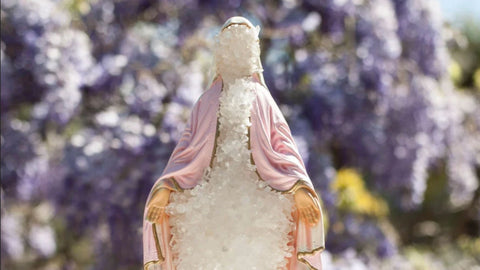As we saw in our post last week, minerals and crystals have fascinated human beings for a very very VERY long time, but why?

The Crystal image has been used extensively in the visual arts over the centuries; indeed, it is so common that it can even be considered almost an obsession . Solid, geometric shapes representing crystals exist in 15th-century art – examples including Jacopo de Barberi's Luca Pacioli portrait (1499), and Durer's Melancholia I (1514), both depicting polyhedra. With its multiple potentialities, at the same time that crystals are a geological phenomenon, they are also seen as objects of aesthetic fascination, flashpoints for affective and also symbolic intensities.

Crystals have been studied by Archimedes, Plato and Aristotle, by Kepler and Descartes, among others. During the Renaissance, crystals were seen as symbols of perfection, which possessed a rational form and all the fundamental elements of life, namely earth, air, fire and water. In most ancient civilizations they were objects of fascination, capable of resonating immutability and transformation simultaneously.
The crystals, these things , articulate in the very narrow line of what is animate, alive , and what is inanimate, dead . And it is around this line of uncertainty that the fascination for crystals exists in the visual arts and in philosophy; because they are indistinguishable in their classification. We know that molecules and chemical components are always (or almost always) classified as organic or inorganic. Because crystals do not contain carbon, they are generally classified as inorganic - yet they grow and change in response to environmental forces, such as what is organic in nature.
While all objects have natural frequencies and vibrations, crystals – especially Quartz harness energy in unusual ways such as in radios, watches, computers, cell phones and…art.
Crystal is thus used as a material, a process and an emerging property in a range of artistic practices. In architecture, the "Michael Lee-Chin Crystal" at the Royal Ontario Museum in Toronto, or the German Expressionist glass architecture of the early 20th century, for example, represent this seduction of crystal, which seems to have an ability to materialize idea of transparency, vitalist transformation and purist stability.

In 2008, artist Roger Hiorns and his team reinforced the walls and ceiling of a ground floor apartment that was to be demolished and covered them with plastic wrap. Then 90,000 liters of a heated solution of copper sulphate was poured through a hole in the ceiling, and after a few weeks, when the temperature of the solution fell, the liquid was removed, paving the way for crystals are forming. A few months later, the whole interior of the house was crystallized. About this work, Hiorns says, “I am not a scientist. I'm more concerned with starting a natural process, which will continue on its own. It never ends, it never stops. Hiorns plays precisely with the organicity, the living aspect of this thing which, according to science, is not organic.


In the works of David Altmejd we notice that the artist plays with this same aspect, this same line between the living and the dead. We see the crystals take on a violent and disturbing form with his hybrid sculptures of human, animal and crystal, especially in Index (2007). Grotesquely beautiful, this work has an aura of science fiction. “Instead of rotting away, the characters in my work are crystallizing. This makes the narrative of the plays go forward, life rather than death” explains Altjmed. Index deploys crystal in a re-conception of animal and human, embodying fundamental creative energies that cross boundaries between animate and inanimate matter.
 David Altjmed, Indexes (2007)
David Altjmed, Indexes (2007) 
Sculptures made for Yeasayer's album Amen & Goodbye on the left and Eye (2015) on the right

Kyle Montgomery in turn uses the sacred icon of the Virgin Mary to incorporate crystals into found sculptures of the saint. Like juxtapositions between spirituality and religion, Montgomery's Virgin is representative of a collision of these two beliefs. The idea of life after death, of the power of the advice and support of both the saint and the crystal, the organic and inorganic form at the same time, everything is present and makes the symbolism of these pieces very strong.







